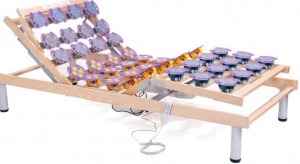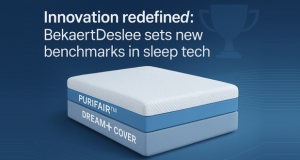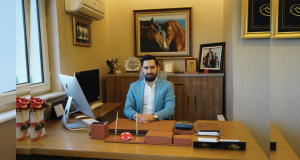 Adjustable bed: An electro-mechanical bed frame construction that permits the raising and lowering of the head and/or foot portions of the mattress. Airbed: A vinyl mattress filled with
Adjustable bed: An electro-mechanical bed frame construction that permits the raising and lowering of the head and/or foot portions of the mattress. Airbed: A vinyl mattress filled with
air. Some are covered with cushioning and ticking and sold with a foundation. Anti-microbial fiber and foam: Treatment that inhibits the growth of microbial contaminates. ASTM: American Society of Testing Materials. An organization dedicated to establishing standard methods and procedures for testing materials. Backing: Any fabric or sheeting material that is used during quilting
to anchor the stitches. Ball rebound test method: See Resilience.
Barrier materials: Generic term referring to woven, non-woven or other materials that are placed between two materials to reduce heat and oxygen transfer from the material outside the barrier to the material under the barrier. For example, a barrier material may be wrapped around the foam cushioning beneath the surface of a mattress to protect the foam from being ignited by burning
materials above the barrier material. Batting: See Cotton felt. Bed: Generally refers to a mattress
and foundation set. Also called “bed set.”
Bed frame: A metal or wood frame with legs used to support a mattress and foundation. Conventional height is 7-1/4 inches (18.41 cm) and the low-profile version is 5-3/4 inches (14.60 cm) when measured from the floor to the bottom of the foundation.
Generally a headboard can be attached. Metal frames are sometimes known as a “Hollywood” frame. Bed frame components: Generally refers to wooden boards used to make the internal frame of a foundation or box spring to which springs are attached. Boards are usually attached together by nails, staples or glue.
Also called “bed frame lumber,” “slats” or “rails,” but does not refer to the bed frame itself. Bedclothes: Top-of-the-mattress accessory items such as blankets, sheets, pillows, comforters, mattress pads, etc.
Bedding: Commonly used as a generic term for a mattress and foundation set, but may also include bedclothes İtems such as blankets, sheets, pillows, comforters, mattress pads, etc.
Bedding ensemble: A complete sleep support system, consisting of a bed frame and head/foot board, mattressand foundation and bedclothes.
Bedsprings: Open-spring or wire fabric box springs without upholstery materials or cover.
Binding tape: Fabric tape used to bind and close the mattress or foundation
where the vertical and horizontal panels of outer ticking come together, providing the edge trimming for the mattress or foundation. See Tape and Tape edge. Board foot: A unit of measurement equal to one square foot of material one inch (2.54 cm) thick. Often used to express quantities of wood and foam.
Boardy: Used to describe a material or finished product having a rigid or stiff feel.
Body impressions: Indentations occurring on the surface of a mattress due to the compression of materials by the human body.
Bonnell: A knotted, round-top, hourglass-shaped steel wire coil. When laced together with cross wire helicals, these coils form the simplest innerspring unit, also referred to as a Bonnell.
Border: The vertical side or edge of a mattress or foundation. Pre-built borders are constructed by stitching together the ticking, foam or other filling materials and a backing material. Commonly quilted or verticalstitched.
Border rod: A heavy gauge wire rod attached to the perimeter of the innerspring unit (top and bottom) by means of a helical wire or metal clips. Boric acid: A chemical additive applied during the garneting of cotton and/or other fibers to provide fire resistance.
Box spring: Also referred to as a “foundation.” A base for a mattress, consisting of coils or other forms of springs mounted on a wood or metal frame and secured with a wireinterlaced or welded-wire grid, typically topped with upholstery and insulating materials (felt, urethane or other resilient materials), and covered on the top and sides with ticking and on the bottom with a dust cover.
Bunk bed: A two-tiered wood or metal frame designed to accommodate two mattresses, typically twin-size, one above the other. Some models allow the upper and lower units to be detached and used as separate beds. Bunkie: A mattress, usually twin-size, and platform base used on bunk beds.
Cal 117: Refers to California Technical Bulletin 117 (also called “TB 117”),
which specifies a vertical flame testing procedure for and furniture component materials. Foam referred to as “Cal 117 foam” has passed this test. Currently under revision by the
California Bureau of Home Furnishings. Cal 129: Refers to California Technical Bulletin 129 (also called “TB129”), which specifies a test protocol for mattresses used in institutional occupancies.
Cal 603: Refers to California Technical Bulletin 603 (also called “TB603”), which is required by California Assembly Bill 603 and will specify product performance and test procedures for mattresses and foundations sold in California. Currently under development by the CBHF.
Cal 604: Refers to California Technical Bulletin 604 (also called “TB604”), which is required by California Assembly Bill 603 and will specify product performance and test procedures for certain filled bedclothes sold in California. Currently under development by the CBHF. California Bureau of Home Furnishings and Thermal Insulation (BHFTI): California government agency that issues and enforces California Technical Bulletins that set flammability performance standards for various products, including mattresses and foundations sold in California. California king: Conventional bedding product with finished mattress dimensions of 72 by 83-1/2 inches (1.83 by 2.12 m).
Carbon: The principal hardening element in steel. The higher the carbon content, the harder the metal and the more temper it will take, thus giving longer shape “memory.” Steel used in inner spring and box springs usually is high carbon steel.
Cellulose acetate pad: Woody fiber compacted into a pad and used as an insulator. May be glued or sandwiched between plastic netting to help hold it together.
Coil count: The number of coils in an innerspring unit. Though the count can effect weight distribution, it is not the determining factor for firmness. The count is usually based on the number
of coils in a full- or queen-size unit. Coils: The individual wire springs that form an innerspring unit. See Hourglass, Continuous and Offset coils. Coir pad: An insulator pad usually made from coconut husk fiber, garneted, needled, bonded and precut to size.
Density: A measure of weight per cubic volume, usually expressed in pounds per cubic foot. Often referred to when discussing foam. Double tempering: Heating of innerspring units, usually in an oven, Tempering. Dual-purpose: A broad term used to include all sleep pieces, that can be converted to other uses, including convertible sofas, high-risers, daybeds, futons, etc. See Convertible sofa.
Dust cover: A woven or non-woven fabric attached to the underside of a foundation to prevent the collection of dust inside. Also known as “sheeting” or “cambric.”
Dynamic fatigue: Laboratory test measurement to simulate extended wear cycles. See also Cornell test and Rollator test.
Edge guard: Generally an extra component added internally to the edge of a mattress and/or box spring to give support on the sides. Egg crate foam: See Convoluted foam. Engineered edge support: A design where the coils on the outer edge of an innerspring unit are actually positioned under the border rod. Fabric cover: Cloth or textile material woven, knitted or felted of any fiber or mixture of fibers. Often referred to as “ticking.” False pad: Compressed cotton felt that is stitched together to retain compression.
Fatigue: Refers generally to degradation of product resulting from use and wear. See Dynamic fatigue, Flex fatigue and Static fatigue.
Fiber pad: Usually refers to man-made or natural fibers (cotton, coir, polyester, etc.) that are garneted, needled, carded and/or bonded together. Normally used as insulators in mattresses and foundations. Filler cloth: Refers to a plain fabric used on the top of a foundation instead of ticking. Commonly offers non-skid characteristics.
Flanging: The process whereby a strip of fabric is sewn to the edge of the mattress cover and, in the assembly process, secured to the perimeter of the innerspring unit to prevent the cover and filling materials from shifting.
Flex fatigue: Laboratory test measurement of cushioning material (usually foam) firmness loss following predetermined number of flexing cycles. Flotation mattress: See Waterbed. Foam foundation: Consists of a builtup wood slat frame covered with a sheet of cardboard or similar material, topped with foam and covered with ticking. Footboard: An upright unit of wood, metal, plastic, or upholstered material, attached at the foot of a bed, usually to the bed frame. Foundation: Any base or support for a mattress, though typically used as a
generic term for box springs. See Box spring and Foam foundation. FPF: Acronym for flexible polyurethane foam. Full: Conventional bedding product with finished mattress dimensions of 53 by 74-1/2 inches (1.35 by 1.89 m). Full extra long: Conventional bedding product with finished mattress dimensions of 53 by 79-1/2 inches (1.35 by 2.02 m).
Futon: A Japanese-style mattress construction, consisting of a cover and filling material, which is typically cotton but can be innerspring and/or foam. Garneting: A mechanical process whereby short cotton fibers and/or other fibers are combed into a specific orientation and formed into a thin web, which are then layered to create a batting used as an upholstery material. See Cotton felt. Gauge: A measurement of the diameter of the steel wire used in coil construction. Wire gauge for innerspring coils range from 12.5 to 17. The higher the gauge, the thinner the wire. Hair pads: Horse tail or mane, cattle tail or hog hair, which has been processed and curled for use as a mattress or upholstery filler.
 SleepTech Magazine Mattress, Accessories, Machinery, Raw Materials
SleepTech Magazine Mattress, Accessories, Machinery, Raw Materials


